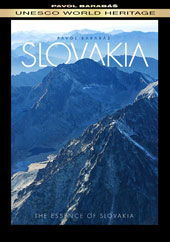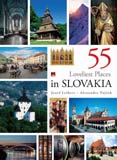55 Loveliest Places in Slovakia
This pictorial publication attests to the bountiful splendours of Slovakia and its natural history. The book captures - not only in words but also with pictures - the culture of the Slovak nation in an historical context, featuring extraordinary places, historical monuments and precious cultural sights all around Slovakia. The rich factual descriptions and depictions, together with the photographs, convey the special and unforgettable atmosphere of every place covered in the book. Text by Jozef Leikert and photographs by Alexander Vojcek.

Preview from the book
BANSKA STIAVNICA
Mining Land of Silver and Gold
Facades of many houses in the town of Banska Stiavnica are decorated with two lizards.
This is because the history of this famous mining town includes a tale of a shepherd who saw two lizards twinkle on a rock - one was silver and the other one golden. He tried to catch them, but the lizards were quick enough to hide beneath the rock. So the shepherd rolled the rock away, and suddenly he was dazzled by the resplendence of silver and gold ore lying below the rock.
Since then the two lizards have come to represent the symbol of the town, which is among the most splendid and romantic in Slovakia. Actually, not only in Slovakia - UNESCO in 1996 included the town on the World Heritage List.
The town grew out of the rocky hills of an inhospitable land. It's nestled on cascades of seven steep hills. Perhaps only thanks to rich deposits of silver and gold ore here, people were willing to cope with the environment and build houses here. Banska Stiavnica officially became a town during the rule of King Belo IV, who granted it with town privilege in 1238.
The greatest boom of the town was seen in the l5th century, when Banska Stiavnica remarkably changed its overall image. New sumptuous houses, as well as sacral and secular buildings appeared, all of them being very original thanks to the fact that they were built in an atypical environment.
Banska Stiavnica, with its steep streets, became the most extraordinary town in the whole Kingdom of Hungary. The town was unable to avoid military and religious tensions, as well as natural disasters causing great damage and loss, but - again, thanks to its wealth - it always managed to recover.

Italian architects, who participated on restorations of many burgher houses in the town, brought here an impressive beauty of the Renaissance style. Thanks to these masters many local buildings even nowadays boast interesting architectonic features which fully respect the uniqueness of this mountainous terrain. In the l7th century, an original site was built in the town - a wooden clapper, called Klopacka, which was used to call miners to come to work, or it was used for giving an alert signal when mining disasters or natural disasters took place.
When rumours started to spread, saying that the local mines would have to be closed, an expert in mining engineering J. K. Hell came to the town with an original plan to rescue the mines. His daring strategy wasn't trusted at first, so the project was submitted to King Charles VI, who eventually approved it. In line with Hell's project, more than 60 artificial mining water reservoirs were built around Banska Stiavnica. The system of tanks was running for many decades to follow, and the energy cumulated in the basins was also used to run mills in the own.

In the l8th century, Banska Stiavnica was the biggest centre of extraction of bullion in the whole monarchy. Turkish threats were by that time averted for good, religious tensions calmed down, truggles between the Hungarian arisocracy and the royal court ceased to exist, and the long-lasting dispute between he mining towns and the public treasury was also settled. All of these were positively reflected in the town's economic and cultural development.
Empress Maria Theresé decided to establish the Mining Academy in Banska Stiavnica, being the first mining academy (meaning university in today's terms) in Europe.
The heart of the town is Trinity Square, historically the most valuable site in Banska Stiavnica. In the l5th century the square was divided into two parts by building the Church of St. Catherine, which resulted in the emergence of two smaller squares, simply referred to as the upper and the lower.
The square is dominated by the massive Plague Column, which was built in the middle of it, following the plague epidemics of 1711. A number of burgher houses lining the square are also impressive.
What's interesting about these houses is the fact that, in the ground beneath them, they still hide corridors leading to old mining adits. These houses also were venues for interesting and historical events, and home to some interesting people.
For example, the Pischle House used to be home to Maria Pischlova, muse of the famous poet Andrej Sladkovic, inspiring him to write the most beautiful love poem in Slovak literature, Marina. Another is the richly decorated Fritz House, which used to be the seat of Mining Academy's Rector's Office, and also included a library and study hall. The Hallenbach House was originally the seat of Court of Mines and later of Mining Academy. Today, it houses the exposition installed by the Slovak Museum of Mining.
Architectonic highlights of the town are definitely the sacral sights on the Scharfenberg Hill. The complex includes three chapels, two churches and a cross with a stone sculpture of Our Lady of Seven Sorrows.
Speaking of sacral sights, the Calvary shouldn't be omitted, the top of which gives you a lovely view of the town and its surroundings.
For perceptive visitors, Banska Stiavnica is an open book of architecture, history and ecology.
Contents
Introduction (7)
Bratislava (8)
Beckov (16)
Bojnice (17)
Dunajská Streda 8)
Komárno (20)
Levice (22)
Malacky (24)
Modra (26)
Nitra (28)
Nove Zamky (34)
Pezinok (36)
Piestany (38)
Senica (40)
Skalica (42)
Sturovo (44)
Topolcany (46)
Trencianske Teplice (48)
Trencin (50)
Trnava (56)
Zlate Moravce (62)
Banska Bystrica (64)
Banska Stiavnica (70)
Brezno (72)
Bytca (73)
Dolny Kubin (74)
Kremnica (76)
Liptovsky Mikulas (78)
Lucenec (80)
Martin (82)
Nova Bana (84)
Povazska Bystrica (86)
Rajec (88)
Rimavska Sobota (90)
Ruzomberok (92)
Slovenska Lupca (94)
Tvrdosin (95)
Zvolen (96)
Zilina (98)
Kosice (102)
Bardejov(108)
Humenne (110)
Kezmarok (112)
Levoca (114)
Michalovce (118)
Podolinec (120)
Poprad, Tatry (122)
Presov (128)
Revuca (132)
Roznava (134)
Sabinov (136)
Spisska Nova Ves (138)
Spisske Podhradie, Spisska Kapitula, Spissky hrad (140)
Stara Lubovna (146)
Svidnik (148)
Vranov nad Toplou (150)
More information:
 Slovakia - Guidebooks and Maps
Slovakia - Guidebooks and Maps
Published: 2007-10-02
Updated: 2007-10-02
Categories: - Help for Travelers - Slovakia










